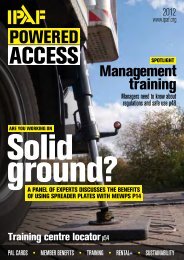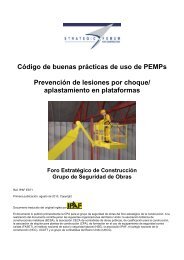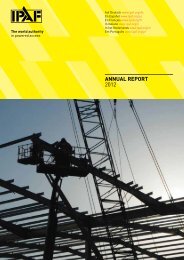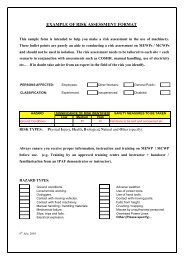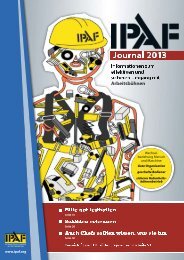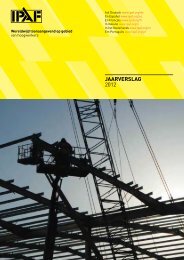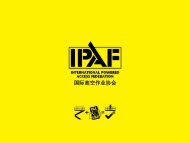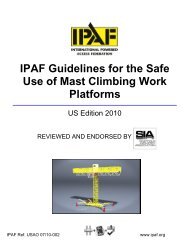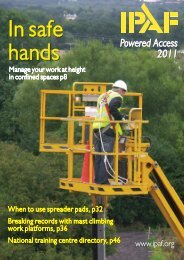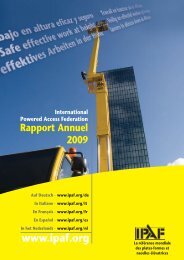Statement of Best Practices of General Training and ... - Ipaf
Statement of Best Practices of General Training and ... - Ipaf
Statement of Best Practices of General Training and ... - Ipaf
Create successful ePaper yourself
Turn your PDF publications into a flip-book with our unique Google optimized e-Paper software.
<strong>Statement</strong> <strong>of</strong> <strong>Best</strong> <strong>Practices</strong><br />
<strong>of</strong> <strong>General</strong> <strong>Training</strong><br />
<strong>and</strong> Familiarization for<br />
Aerial Work<br />
Platform Equipment<br />
Contributed by:<br />
February 2010<br />
02-10-AWP-SBP001
Industry Commitment<br />
All in the industry — rental operators, manufacturers,<br />
associations for those entities, educators, regulators,<br />
users <strong>and</strong> operators — are dedicated to the best practices<br />
related to the training <strong>and</strong> safe use <strong>of</strong> aerial work platform<br />
(AWP) equipment. Proper use achieves successful project<br />
completion <strong>and</strong> assures operator safety. This is particularly<br />
critical when working with AWP equipment, which <strong>of</strong>fers<br />
so much versatility <strong>and</strong> assistance to those who use it. The<br />
priority <strong>of</strong> all in the industry is to make sure that everyone<br />
who owns <strong>and</strong> operates AWP equipment has a clear<br />
underst<strong>and</strong>ing <strong>of</strong> his or her role in the requirements for<br />
the safe use <strong>of</strong> that equipment.<br />
The industry has joined forces to clarify those responsibilities,<br />
particularly in the areas <strong>of</strong> general training <strong>and</strong> familiarization.<br />
We are committed to put forth initiatives that increase<br />
awareness <strong>of</strong> best practices, clarify responsibilities <strong>and</strong> address<br />
the safe use <strong>of</strong> equipment.<br />
This <strong>Statement</strong> <strong>of</strong> <strong>Best</strong> <strong>Practices</strong> <strong>of</strong> <strong>General</strong> <strong>Training</strong> <strong>and</strong> Familiarization for Aerial Work Platform Equipment (this “<strong>Statement</strong>”)<br />
developed by the American Rental Association, the Association <strong>of</strong> Equipment Manufacturers, the Scaffold Industry Association, the<br />
Associated Equipment Distributors, <strong>and</strong> the International Powered Access Federation (collectively, the “Associations”) is intended<br />
to provide general guidance <strong>and</strong> best practices in training <strong>and</strong> safe use <strong>of</strong> aerial work platform (“AWP”) equipment <strong>and</strong> summarize<br />
certain st<strong>and</strong>ards <strong>and</strong> regulations published by the American National St<strong>and</strong>ards Institute <strong>and</strong> the Occupational Safety <strong>and</strong> Health<br />
Administration. The Associations do not purport to include in this <strong>Statement</strong> all st<strong>and</strong>ards <strong>and</strong> regulations applicable to the use<br />
<strong>of</strong> AWP equipment <strong>and</strong> any reference in this <strong>Statement</strong> to such st<strong>and</strong>ards <strong>and</strong> regulations should be read in conjunction with the<br />
st<strong>and</strong>ards <strong>and</strong> regulations in their entirety. Each individual or company should use its own independent judgment <strong>and</strong> discretion in<br />
successfully implementing the materials in this <strong>Statement</strong> to best fit the unique needs <strong>of</strong> its business.<br />
Each <strong>of</strong> the Associations expressly disclaims any warranties or guarantees, express or implied, <strong>and</strong> none <strong>of</strong> the Associations shall<br />
be liable for damages <strong>of</strong> any kind in connection with the material, information, or procedures set forth in this <strong>Statement</strong> or for<br />
reliance on the contents <strong>of</strong> this <strong>Statement</strong>. In issuing this <strong>Statement</strong>, none <strong>of</strong> the Associations is engaged in rendering legal or other<br />
pr<strong>of</strong>essional services. This <strong>Statement</strong> is not a substitute for applicable laws, st<strong>and</strong>ards <strong>and</strong> regulations <strong>and</strong> does not alter or limit the<br />
obligation <strong>of</strong> member companies to fully comply with federal, state <strong>and</strong> local law <strong>and</strong> prudent safety measures relating to the use <strong>of</strong><br />
aerial work platform equipment. This <strong>Statement</strong> is not intended to create new legal liabilities or exp<strong>and</strong> existing rights or obligations.<br />
2 02-10-AWP-SBP001
Industry Initiative<br />
The first tangible result <strong>of</strong> this industry initiative<br />
is this document, <strong>Statement</strong> <strong>of</strong> <strong>Best</strong> <strong>Practices</strong> <strong>of</strong><br />
<strong>General</strong> <strong>Training</strong> <strong>and</strong> Familiarization for Aerial<br />
Work Platform Equipment. The guide has been completed<br />
for all in the industry to present a clear <strong>and</strong> concise<br />
underst<strong>and</strong>ing <strong>of</strong> what is required by all parties when it<br />
comes to general training <strong>and</strong> familiarization.<br />
AWP equipment manufacturers, dealers, rental<br />
companies <strong>and</strong> industry stakeholders recommend<br />
that users <strong>of</strong> this equipment read, underst<strong>and</strong> <strong>and</strong><br />
implement the information in this document throughout<br />
their businesses. For answers to questions, contact<br />
any <strong>of</strong> the associations that have contributed to<br />
this document.<br />
The goal is to continue to provide this quality <strong>of</strong><br />
information to the industry. Please join with us in<br />
achieving our priority to enhance the implementation<br />
<strong>of</strong> AWP equipment safety measures throughout<br />
the industry.<br />
»<br />
Goals <strong>of</strong> this initiative:<br />
• Increase the safe use <strong>of</strong> AWP equipment.<br />
• Exp<strong>and</strong> the risk management knowledge<br />
about these machines throughout<br />
the industry.<br />
02-10-AWP-SBP001<br />
3
Table <strong>of</strong> Contents<br />
I. Introduction .........................................................................................5<br />
II. Definitions .............................................................................................6<br />
III. Situation Analysis ...............................................................................7<br />
IV. Current AWP Equipment Associations, Governing Bodies<br />
<strong>and</strong> St<strong>and</strong>ards .......................................................................................8-9<br />
V. ANSI <strong>and</strong> OSHA Roles <strong>and</strong> Compliance Requirements ......10<br />
VI. <strong>General</strong> <strong>Training</strong> <strong>and</strong> Familiarization for the Operator<br />
Overview .....................................................................................................11<br />
<strong>General</strong> <strong>Training</strong> ..........................................................................................12<br />
Model-specific Familiarization ......................................................................13<br />
<strong>General</strong> <strong>Training</strong> vs. Familiarization ..............................................................14<br />
VII. Trainer<br />
Qualifications ..............................................................................................15<br />
Attributes .....................................................................................................15<br />
VIII. Roles <strong>and</strong> Responsibilities Regarding <strong>General</strong> <strong>Training</strong><br />
<strong>and</strong> Familiarization ............................................................................16<br />
<strong>General</strong> <strong>Training</strong> ..........................................................................................17<br />
Familiarization .............................................................................................18<br />
IX. Record Retention <strong>and</strong> Pro<strong>of</strong> <strong>of</strong> the Operator’s Qualifications<br />
<strong>General</strong> <strong>Training</strong> ..........................................................................................19<br />
Familiarization .............................................................................................19<br />
4<br />
02-10-AWP-SBP001
Section I: Introduction<br />
To increase the safe use <strong>of</strong> AWP equipment <strong>and</strong> exp<strong>and</strong> AWP equipment risk<br />
management knowledge throughout the industry, those from the industry have<br />
joined forces to create an industry-recognized <strong>Statement</strong> <strong>of</strong> <strong>Best</strong> <strong>Practices</strong> <strong>of</strong><br />
<strong>General</strong> <strong>Training</strong> <strong>and</strong> Familiarization for Aerial Work Platform (AWP) Equipment.<br />
This initiative is the result <strong>of</strong> recognized inconsistencies in the interpretation <strong>of</strong><br />
what is general training <strong>and</strong> familiarization <strong>and</strong> how each is being delivered in<br />
the industry.<br />
»<br />
Intent <strong>of</strong> this initiative is to:<br />
• Educate the industry on the industry-recognized-<strong>and</strong>supported<br />
st<strong>and</strong>ards, including the American National<br />
St<strong>and</strong>ards Institute/Scaffold Industry Association (ANSI/<br />
SIA) A92 St<strong>and</strong>ards <strong>and</strong> the Occupational Safety &<br />
Health Administration (OSHA) regulations.<br />
• Present best practices <strong>and</strong> minimum general<br />
training guidelines for AWP equipment<br />
operators.<br />
• Emphasize the differences between general<br />
training <strong>and</strong> familiarization.<br />
• Clarify minimum qualifications <strong>of</strong><br />
the trainer.<br />
02-10-AWP-SBP001<br />
5
Section II: Definitions<br />
The following terms <strong>and</strong> definitions from the ANSI/SIA A92 St<strong>and</strong>ards provide a common<br />
underst<strong>and</strong>ing when each is referenced throughout this document. Refer to these when reading<br />
each section.<br />
Stakeholders<br />
Dealer/Rental Company:<br />
Manufacturer:<br />
Operator:<br />
Owner:<br />
Qualified Person:<br />
User:<br />
A person or entity who buys from a manufacturer or<br />
distributor <strong>and</strong> who generally sells, rents, <strong>and</strong> services<br />
aerial platforms.<br />
A person or entity who makes, builds, or produces an<br />
aerial platform.<br />
A qualified person who controls the movement <strong>of</strong> an<br />
aerial platform.<br />
A person or entity who has possession <strong>of</strong> an aerial platform<br />
by virtue <strong>of</strong> pro<strong>of</strong> <strong>of</strong> purchase.<br />
One who, by possession <strong>of</strong> a recognized degree, certificate,<br />
or pr<strong>of</strong>essional st<strong>and</strong>ing, or by extensive knowledge, training,<br />
<strong>and</strong> experience, has successfully demonstrated his/her ability<br />
to solve or resolve problems related to the subject matter, the<br />
work, or the project.<br />
A person(s) or entity who has care, control <strong>and</strong> custody<br />
<strong>of</strong> the aerial platform. This person or entity may also be<br />
the employer <strong>of</strong> the operator, a dealer, owner, or operator.<br />
<strong>General</strong><br />
Aerial Work Platform (AWP):<br />
Familiarization:<br />
<strong>General</strong> <strong>Training</strong>:<br />
A mobile or manually propelled device that has an adjustable<br />
position platform, supported from ground level by a structure.<br />
Providing information regarding the control functions<br />
<strong>and</strong> safety devices for the aerial platform(s) to a qualified<br />
person or operator who controls the movement <strong>of</strong> the aerial<br />
platform(s) being delivered.<br />
Instruction to enable the trainee to become a qualified person<br />
regarding the task to be performed, including knowledge<br />
regarding potential hazards.<br />
6 02-10-AWP-SBP001
Section III: Situation Analysis<br />
Many programs are available for training operators <strong>of</strong> AWP equipment. Despite this fact,<br />
there continues to be a lack <strong>of</strong> properly trained operators <strong>of</strong> aerial work platform equipment.<br />
In addition, there is a need to ensure that employers are aware <strong>of</strong> the training requirements<br />
<strong>and</strong> where to access training materials that meet or exceed minimum st<strong>and</strong>ards. After<br />
providing appropriate training, the employer must monitor the operator’s performance <strong>and</strong><br />
that individual’s work to ensure the use, application <strong>and</strong> operation <strong>of</strong> AWP equipment is in<br />
conformance with the provisions defined for operators in the ANSI st<strong>and</strong>ards. Though the<br />
equipment is safe when properly used, training materials that address these needs could raise<br />
the level <strong>of</strong> operator safety even more.<br />
Current ANSI/SIA A92 St<strong>and</strong>ards outline the subject matter for operators <strong>and</strong> trainers <strong>of</strong> AWP<br />
equipment, but they do not establish quantitative requirements to be met for the qualification<br />
<strong>of</strong> operators or for the trainers.<br />
The responsibility for training is currently upon the employer/user to train operators <strong>of</strong> AWP<br />
equipment. Section 8.5.1 <strong>of</strong> ANSI/SIA A92 St<strong>and</strong>ards lists what should be included in operator<br />
general training, <strong>and</strong> Section 8.5.3 <strong>of</strong> those same st<strong>and</strong>ards addresses what should be included<br />
in familiarization. However, neither answers the question regarding what requirements are to<br />
be met to educate operators to a minimum st<strong>and</strong>ard. This document recommends the best<br />
practices for those minimum requirements.<br />
»<br />
Issues facing the<br />
industry:<br />
• Underst<strong>and</strong>ing the importance <strong>of</strong> proper<br />
general training <strong>and</strong> familiarization.<br />
• Improper training.<br />
• Confusion between general training <strong>and</strong> familiarization.<br />
• Misunderst<strong>and</strong>ing <strong>of</strong> who is qualified to be a trainer.<br />
• Need for clarification <strong>of</strong> all AWP equipment<br />
stakeholders’ responsibilities.<br />
• Impact on insurance.<br />
02-10-AWP-SBP001<br />
7
Section IV: Current AWP Equipment<br />
Associations, Governing<br />
Bodies <strong>and</strong> St<strong>and</strong>ards<br />
Associations<br />
The associations involved in this effort include:<br />
• American Rental Association (ARA) is the international<br />
trade association for the equipment rental industry, including<br />
rental businesses <strong>and</strong> suppliers to the industry. ARA provides<br />
educational, insurance/risk management, business management<br />
<strong>and</strong> marketing resources; networking opportunities; industry<br />
research; <strong>and</strong> legislative <strong>and</strong> regulatory advocacy for its members.<br />
• Associated Equipment Distributors (AED) is an<br />
international trade association representing companies involved<br />
in the distribution, rental <strong>and</strong> support <strong>of</strong> equipment used in<br />
construction, mining, forestry, power generation, agriculture <strong>and</strong><br />
industrial applications. AED enhances the ongoing success <strong>and</strong><br />
pr<strong>of</strong>itability <strong>of</strong> its member companies <strong>and</strong> related constituencies<br />
through public policy advocacy; industry education, training<br />
<strong>and</strong> career development; networking opportunities; as well as<br />
research, <strong>and</strong> performance benchmarks.<br />
• Association <strong>of</strong> Equipment Manufacturers (AEM) is the<br />
North American-based international trade group representing<br />
the <strong>of</strong>f-road equipment manufacturing industry, <strong>and</strong> its<br />
members manufacture equipment, products <strong>and</strong> services<br />
used worldwide in the agriculture, construction, forestry,<br />
mining <strong>and</strong> utility sectors.<br />
• International Powered Access Federation (IPAF) is the<br />
specialist international trade association representing rental<br />
companies, manufacturers <strong>and</strong> the end users <strong>of</strong> every type <strong>of</strong><br />
aerial work platform. IPAF provides training programs, lobbying,<br />
market research, business advice <strong>and</strong> other resources to members<br />
<strong>and</strong> nonmembers as part <strong>of</strong> its worldwide mission to “promote<br />
the safe <strong>and</strong> effective use <strong>of</strong> powered access.”<br />
• Scaffold Industry Association (SIA) is a nonpr<strong>of</strong>it trade<br />
association committed to raising the st<strong>and</strong>ards <strong>of</strong> pr<strong>of</strong>essionalism<br />
within the scaffold <strong>and</strong> access industry. The SIA represents all<br />
facets <strong>of</strong> the scaffold <strong>and</strong> access industry. Through its various<br />
programs, the SIA promotes safety, training <strong>and</strong> a highly<br />
pr<strong>of</strong>essional, responsible image <strong>of</strong> the scaffold <strong>and</strong> access<br />
pr<strong>of</strong>essional. The SIA is also the secretariat for the American<br />
National St<strong>and</strong>ard, ASC A92 St<strong>and</strong>ards.<br />
8 02-10-AWP-SBP001
Governing Bodies<br />
The governing body that provides guidelines <strong>and</strong> regulations includes:<br />
• Occupational Safety & Health Administration (OSHA) is an agency <strong>of</strong> the U.S.<br />
Department <strong>of</strong> Labor <strong>and</strong> the main federal agency charged with the enforcement <strong>of</strong> safety <strong>and</strong><br />
health legislation. Under the Occupational Safety <strong>and</strong> Health Act <strong>of</strong> 1970, OSHA’s role is to assure<br />
safe <strong>and</strong> healthful conditions for working men <strong>and</strong> women by authorizing enforcement <strong>of</strong> the<br />
st<strong>and</strong>ards developed under the Act, by assisting <strong>and</strong> encouraging the states in their efforts to<br />
assure safe <strong>and</strong> healthful working conditions, by providing for research, information, education<br />
<strong>and</strong> training in the field <strong>of</strong> occupational safety <strong>and</strong> health.<br />
St<strong>and</strong>ards<br />
The entities <strong>and</strong> st<strong>and</strong>ards that impact owners <strong>and</strong> operators <strong>of</strong> AWP equipment include:<br />
• American National St<strong>and</strong>ards Institute (ANSI) is the voice <strong>of</strong> the U.S. st<strong>and</strong>ards <strong>and</strong><br />
conformity assessment system. The Institute oversees the creation, dissemination <strong>and</strong> the<br />
use <strong>of</strong> thous<strong>and</strong>s <strong>of</strong> norms <strong>and</strong> guidelines that directly impact businesses in nearly every<br />
business sector.<br />
• The ASC A92 Main Committee is the consensus body approved through ANSI.<br />
The ASC A92 Main Committee reports to ANSI through its secretariat, SIA. The main<br />
committee is made up <strong>of</strong> various organizations. The individuals on the committee<br />
represent their respective organizations. The subcommittees are made up <strong>of</strong> individuals<br />
who represent themselves. The goal is to make each committee a balance <strong>of</strong> interested<br />
classes. The classifications are: consumers/users, distributors/dealers, experts, regulatory<br />
agencies, manufacturers, testing laboratories <strong>and</strong> not-for-pr<strong>of</strong>it or for-pr<strong>of</strong>it entities.<br />
• ASC A92 St<strong>and</strong>ards are developed by the A92 Main Committee <strong>and</strong> are applicable to U.S.<br />
operations. They are used by manufacturers, dealers, owners, users <strong>and</strong> operators <strong>of</strong> AWP<br />
equipment. The purpose <strong>of</strong> the st<strong>and</strong>ards is the proper <strong>and</strong> safe use <strong>of</strong> machines <strong>and</strong> the<br />
prevention <strong>of</strong> accidents <strong>and</strong> injuries. These st<strong>and</strong>ards also establish criteria for the manufacturers<br />
as well as aid the manufacturers, dealers, owners, users <strong>and</strong> operators <strong>of</strong> AWP equipment to<br />
underst<strong>and</strong> their various responsibilities. This document references the following A92 St<strong>and</strong>ards:<br />
• A92.3 – Manually propelled elevating aerial platforms (push-around)<br />
• A92.5 – Boom-supported elevating work platforms (boom lifts)<br />
• A92.6 – Self-propelled elevating work platforms (scissor lifts)<br />
• Towable work platforms, included in A92.2 (trailer-mounted boom lifts)<br />
The A92 St<strong>and</strong>ards are published in two forms:<br />
• Full ANSI A92 St<strong>and</strong>ards<br />
• ANSI/SIA Manuals <strong>of</strong> Responsibilities are abbreviated versions <strong>of</strong> the full ANSI A92<br />
St<strong>and</strong>ards. They contain everything that is in the full st<strong>and</strong>ards except Sections 1 <strong>and</strong> 2 <strong>of</strong><br />
the st<strong>and</strong>ard <strong>and</strong> the manufacturers’ responsibilities.<br />
02-10-AWP-SBP001<br />
9
Section V: ANSI <strong>and</strong> OSHA Roles <strong>and</strong><br />
Compliance Requirements<br />
Roles <strong>of</strong> ANSI <strong>and</strong> OSHA<br />
ANSI promotes safety in the industry by developing recommendations in the form <strong>of</strong> st<strong>and</strong>ards <strong>and</strong><br />
guidelines. While ANSI st<strong>and</strong>ards are considered best practices, they are not laws or regulations.<br />
Complying with ANSI st<strong>and</strong>ards is voluntary.<br />
OSHA is an agency <strong>of</strong> the U.S. government that issues <strong>and</strong> enforces regulations for employers to<br />
ensure workplace safety <strong>and</strong> health. Though the regulations are <strong>of</strong>ten referred to as st<strong>and</strong>ards, they<br />
are in fact laws <strong>and</strong> therefore compliance is m<strong>and</strong>atory.<br />
Reasons for Complying<br />
ANSI st<strong>and</strong>ards <strong>and</strong> OSHA regulations are <strong>of</strong>ten confused because they generally address the<br />
same issues. In fact, many OSHA regulations were written based on ANSI st<strong>and</strong>ards. Also, OSHA<br />
<strong>of</strong>ten adopts ANSI st<strong>and</strong>ards via “incorporation by reference.” When st<strong>and</strong>ards are adopted or<br />
incorporated, they become part <strong>of</strong> the OSHA regulation <strong>and</strong> are no longer voluntary.<br />
Although ANSI st<strong>and</strong>ards are technically voluntary, it is in every company’s best interest to<br />
comply with them. Even when they are not incorporated into OSHA regulations, employers are<br />
expected to acknowledge them since they represent a consensus on what experts consider safe.<br />
Also, not following st<strong>and</strong>ards may be considered a violation <strong>of</strong> OSHA’s “general duty” clause,<br />
which requires employers to keep the workplace “free from recognized hazards.” Finally, since<br />
ANSI st<strong>and</strong>ards are considered best practices, they are viewed as the legal “st<strong>and</strong>ard <strong>of</strong> care.”<br />
Noncompliance can equate to negligence <strong>and</strong> legal liability in the event <strong>of</strong> an injury.<br />
OSHA refers to ANSI st<strong>and</strong>ards for industry best practices.<br />
OSHA has written many rules in the Code <strong>of</strong> Federal Regulations, but in some cases has adopted<br />
consensus st<strong>and</strong>ards to be used as minimum guidelines by their reference in the Code <strong>of</strong> Federal<br />
Regulations. In 1974, they adopted many <strong>of</strong> the ANSI <strong>and</strong> NFPA (National Fire Protection Association)<br />
st<strong>and</strong>ards in order to promote safety rules. In this particular time frame, there was only one aerial lift<br />
st<strong>and</strong>ard, A92.2-1969 for vehicle-mounted elevating <strong>and</strong> rotating work platforms.<br />
ANSI has since created other st<strong>and</strong>ards for other types <strong>of</strong> aerial lifts <strong>and</strong> OSHA observes these<br />
consensus st<strong>and</strong>ards. OSHA also has recognized using these updated consensus st<strong>and</strong>ards through<br />
interpretive letters regarding compliance. Therefore, ANSI st<strong>and</strong>ards must be the governing<br />
documents used going forward to establish minimum requirements for training.<br />
All contributing organizations fully support the ANSI/SIA A92 St<strong>and</strong>ards as the recognized st<strong>and</strong>ards<br />
for AWP equipment. The associations <strong>and</strong> their members are actively involved on the A92 Main <strong>and</strong><br />
Subcommittees. Incorporating changes regarding minimum levels <strong>of</strong> training into these ANSI/SIA<br />
publications is a long-term goal <strong>of</strong> these organizations.<br />
10 02-10-AWP-SBP001
Section VI: <strong>General</strong> <strong>Training</strong> <strong>and</strong><br />
Familiarization for the Operator<br />
Overview<br />
According to the ANSI/SIA A92 St<strong>and</strong>ards, when a user directs or authorizes an individual to<br />
operate an aerial work platform, the user must ensure that the individual is trained before<br />
being assigned to operate it. The operator must receive general training on the type <strong>of</strong> AWP<br />
equipment being assigned. Instructions should include the inspection, application, recognition<br />
<strong>and</strong> avoidance <strong>of</strong> hazards associated with that equipment. Additionally, the operator must<br />
receive AWP equipment model-specific familiarization on the particular model that he/she will<br />
be operating.<br />
Both general training <strong>and</strong> familiarization are currently outlined in the ANSI/SIA Manuals <strong>of</strong><br />
Responsibilities <strong>and</strong> the full ANSI/SIA A92 St<strong>and</strong>ards.<br />
<strong>General</strong> <strong>Training</strong><br />
Familiarization<br />
Prepares an operator to operate<br />
Multiple pieces <strong>of</strong> equipment <strong>of</strong> a<br />
particular type<br />
Push-around<br />
Boom lifts<br />
Scissor lifts<br />
Trailer-mounted boom lifts<br />
Classroom/formal + h<strong>and</strong>s-on/practical<br />
A specific model<br />
Manufacturer X Model XXX<br />
Manufacturer Y Model YYY<br />
Manufacturer Z Model ZZZ<br />
Prior to use<br />
+<br />
or +<br />
02-10-AWP-SBP001<br />
11
<strong>General</strong> <strong>Training</strong><br />
<strong>General</strong> instructions for operators regarding the inspection, application <strong>and</strong> operation <strong>of</strong> AWP<br />
equipment, including recognition <strong>and</strong> avoidance <strong>of</strong> hazards associated with their use, are covered<br />
in Section 8.5.1 <strong>of</strong> ANSI/SIA St<strong>and</strong>ards A92.3, A92.5 <strong>and</strong> A92.6. (See page 17 for details <strong>of</strong> the<br />
st<strong>and</strong>ards.) These <strong>and</strong> other industry practices require the inclusion <strong>of</strong>, but are not necessarily<br />
limited to, the following issues <strong>and</strong> requirements:<br />
• The actual operation <strong>of</strong> the aerial platform “under the direction <strong>of</strong> a qualified person.”<br />
• The need for the trainee to operate the aerial platform(s) for a sufficient period <strong>of</strong> time to<br />
demonstrate pr<strong>of</strong>iciency in the actual operation <strong>of</strong> all functions <strong>of</strong> the aerial platform.<br />
• That much <strong>of</strong> the general training should take place in the classroom.<br />
• Regulations <strong>and</strong> st<strong>and</strong>ards.<br />
• The need to perform workplace inspections.<br />
• Recognition <strong>and</strong> avoidance <strong>of</strong> common hazards.<br />
• Operator warnings <strong>and</strong> instructions.<br />
• The purpose <strong>and</strong> use <strong>of</strong> manuals.<br />
• A pre-start inspection.<br />
• Factors affecting stability.<br />
• Personal protective equipment.<br />
• <strong>General</strong> equipment components.<br />
• Safe use <strong>of</strong> equipment.<br />
• The proper selection <strong>of</strong> the AWP equipment for the job at h<strong>and</strong>.<br />
• The application <strong>and</strong> underst<strong>and</strong>ing <strong>of</strong> typical options that are likely associated with larger<br />
machines: e.g. outriggers/stabilizers, extendable axles, envelope management systems, loadmoment<br />
devices, dual capacity.<br />
When properly completed, general training is the first step toward qualifying an operator to<br />
operate any like-type <strong>of</strong> AWP equipment as long as he/she is also familiarized with the controls<br />
<strong>and</strong> safety devices <strong>of</strong> the other like-type equipment.<br />
Important!<br />
When general training takes place on a particular model <strong>of</strong> equipment, operating<br />
other equipment models, which were not included in this initial instruction, places<br />
the operator <strong>and</strong> others at risk without additional familiarization.<br />
For example, an operator who does not underst<strong>and</strong>/is not familiar with all the controls, safety<br />
devices <strong>and</strong> operating characteristics on a subsequently used piece <strong>of</strong> equipment may not know<br />
how to get the unit down in the event <strong>of</strong> engine failure or other such emergency.<br />
This is expressly why, in addition to initial general training <strong>of</strong> individuals, the need<br />
for familiarization with each piece <strong>of</strong> equipment is so critical.<br />
12 02-10-AWP-SBP001
Model-specific Familiarization<br />
Familiarization for operators is listed in three component parts in Section 8.5.3 <strong>of</strong> the ANSI/<br />
SIA A92.3, A92.5 <strong>and</strong> A92.6 St<strong>and</strong>ards:<br />
“Familiarization. When an operator is directed to operate an aerial platform he/she is<br />
not familiar with, the operator shall receive instructions regarding the following items:<br />
1. The location <strong>of</strong> the weather resistant compartment (for manual storage).<br />
It is the responsibility <strong>of</strong> the operator to ensure that the correct manuals are in fact on<br />
board the unit as required by Section 8.2 <strong>of</strong> the ANSI/SIA A92 St<strong>and</strong>ards <strong>and</strong> that he/<br />
she be familiar with the manuals <strong>and</strong> reference them as required in Section 8.2.1.<br />
2. The purpose <strong>and</strong> function <strong>of</strong> all controls.<br />
3. Safety devices <strong>and</strong> operating characteristics specific to the aerial platform.”<br />
The user <strong>of</strong> the equipment shall ensure that the operator is familiar with the piece<br />
<strong>of</strong> equipment he/she is directed to operate. Familiarization must be facilitated by a<br />
qualified person. Only a trained <strong>and</strong> qualified person may self-familiarize by reading <strong>and</strong><br />
underst<strong>and</strong>ing the manufacturer’s operating instructions <strong>and</strong> user’s safety rules —<br />
or have it explained if there are questions.<br />
02-10-AWP-SBP001<br />
13
<strong>General</strong> <strong>Training</strong> vs. Familiarization<br />
The following chart illustrates best practices that are associated with general training <strong>and</strong> familiarization.<br />
ANSI <strong>General</strong> <strong>Training</strong><br />
ANSI Familiarization<br />
Location: Classroom/formal + h<strong>and</strong>s-on/practical Prior to use (on the machine)<br />
Length:<br />
3-6 hours or more, depending on class<br />
size <strong>and</strong> number <strong>of</strong> equipment<br />
classifications to be covered<br />
15-60 minutes or more<br />
Facilitated by: Qualified AWP equipment instructor Qualified person (i.e., driver, salesperson,<br />
supervisor or trainer)<br />
Material<br />
covered:<br />
Regulatory/<br />
reference<br />
documents:<br />
Equipment:<br />
Frequency:<br />
Record<br />
dissemination:<br />
Record<br />
retention:<br />
ANSI lists 11 required items related to the<br />
operation <strong>of</strong> the equipment, including<br />
decals <strong>and</strong> pre-start inspections.<br />
• Basically, the operator needs to be<br />
trained about the safe operation<br />
<strong>of</strong> the specific models present at<br />
training.<br />
• Under the direction <strong>of</strong> a qualified<br />
instructor, the operator needs to<br />
demonstrate pr<strong>of</strong>iciency in the actual<br />
operation <strong>of</strong> the equipment.<br />
• OSHA 1910, 1926.453<br />
• ANSI/SIA A92.2, A92.3, A92.5,<br />
A92.6 St<strong>and</strong>ards <strong>and</strong> Manuals <strong>of</strong><br />
Responsibilities<br />
• Manufacturer’s operating manual<br />
<strong>General</strong>ly, trained on one or more types<br />
<strong>of</strong> equipment classifications:<br />
• Boom lifts • Push-around<br />
• Scissor lifts • Trailer-mounted<br />
boom lifts<br />
• Prior to use<br />
• Retrained:<br />
• At least every five years<br />
• After a job change<br />
• Observation <strong>and</strong> evaluation <strong>of</strong><br />
the operator<br />
The following forms <strong>of</strong> documentation<br />
should be available from the employer/<br />
training company <strong>and</strong> should include<br />
pro<strong>of</strong> <strong>of</strong> training for an operator:<br />
• Operator certificate (optional)<br />
• Operator wallet card (optional)<br />
• Hard hat sticker (optional)<br />
The employer <strong>and</strong> trainer should<br />
retain the following documentation<br />
for four years:<br />
• Name <strong>of</strong> trainee<br />
• Name <strong>of</strong> entity providing training<br />
or retraining<br />
• Name <strong>of</strong> trainer<br />
• Date <strong>of</strong> general training<br />
• Type <strong>of</strong> equipment classification<br />
training occurred on<br />
Covers the:<br />
• Location <strong>of</strong> manuals as specified by the<br />
manufacturer<br />
• Control functions: How to start the<br />
machine, move the machine, activate<br />
the deck extensions, steer <strong>and</strong> use<br />
outriggers, etc.<br />
• Safety devices, including location <strong>of</strong> the<br />
anchorage points <strong>and</strong> tilt alarms<br />
• ANSI/SIA A92.2, A92.3, A92.5,<br />
A92.6 St<strong>and</strong>ards <strong>and</strong> Manuals <strong>of</strong><br />
Responsibilities<br />
• Manufacturer’s operating manual<br />
Model-specific<br />
Prior to use (model-specific)<br />
Names <strong>of</strong> those familiarized, the<br />
name <strong>of</strong> the person who performed<br />
the familiarization <strong>and</strong> the dates <strong>of</strong><br />
familiarization<br />
The employer <strong>and</strong> the trainer need to<br />
retain the following for four years:<br />
• Name <strong>of</strong> the person receiving<br />
familiarization<br />
• Date <strong>of</strong> familiarization<br />
• Equipment covered in familiarization<br />
• Identity <strong>of</strong> the person(s) performing<br />
the familiarization<br />
14 02-10-AWP-SBP001
Section VII: Trainer<br />
Qualifications<br />
The ANSI/SIA A92 St<strong>and</strong>ards have defined a qualified person as follows. This pertains to operators<br />
<strong>and</strong> trainers alike:<br />
“Qualified Person. One who, by possession <strong>of</strong> a recognized degree, certificate, or pr<strong>of</strong>essional<br />
st<strong>and</strong>ing, or by extensive knowledge, training, <strong>and</strong> experience, has successfully demonstrated<br />
his/her ability to solve or resolve problems related to the subject matter, the work, or the project.”<br />
Attributes<br />
The following is a suggested list <strong>of</strong> attributes a trainer will need in order to successfully educate operators:<br />
»<br />
»<br />
»<br />
Skills/knowledge<br />
3 Must know the rules, regulations <strong>and</strong> st<strong>and</strong>ards.<br />
3 Needs to have knowledge <strong>of</strong> the equipment, the operator safety manual, warning<br />
decals <strong>and</strong> placards.<br />
3 Possesses awareness <strong>of</strong> potential hazards <strong>and</strong> the means to protect against<br />
identified hazards.<br />
3 Be able to identify <strong>and</strong> avoid potential workplace hazards.<br />
3 Underst<strong>and</strong>s manufacturer’s guidelines for proper/improper use <strong>and</strong> application <strong>of</strong><br />
the equipment.<br />
3 Knows the consequences <strong>of</strong> improper use <strong>and</strong> application <strong>of</strong> the equipment.<br />
3 Has a good safety record that is based on consistent implementation <strong>of</strong> the rules.<br />
Communication<br />
3 Possesses good communication <strong>and</strong> presentation skills when speaking with groups<br />
or individuals.<br />
3 Knows <strong>and</strong> underst<strong>and</strong>s the teaching methods <strong>and</strong> learning styles <strong>of</strong> adult learners.<br />
3 Be able to obtain acknowledgement from the operator that he/she can implement<br />
the training.<br />
3 Has the ability to deliver training in a manner <strong>and</strong> language appropriate to ensure<br />
underst<strong>and</strong>ing by the audience.<br />
Qualities<br />
3 Possesses a concern for the welfare <strong>of</strong> others so trainers can serve as a safety advocate.<br />
3 Be intuitive <strong>and</strong> perceptive with people, i.e., can “read” the audience.<br />
3 Works in a confident <strong>and</strong> honest manner with people.<br />
02-10-AWP-SBP001<br />
15
Section VIII: Roles <strong>and</strong> Responsibilities<br />
Regarding <strong>General</strong> <strong>Training</strong><br />
<strong>and</strong> Familiarization<br />
The following chart on page 17 contains explanations that clarify responsibilities for both training<br />
<strong>and</strong> familiarization. Various entities have specific responsibilities in regards to general training <strong>and</strong><br />
familiarization. The same entity may serve in different roles such as a dealer <strong>and</strong> user. For instance,<br />
whenever an entity is serving in the role <strong>of</strong> the dealer, the following responsibilities are enacted:<br />
<strong>General</strong> <strong>Training</strong><br />
It is the dealer’s responsibility to assist its customers in identifying training resources in order to satisfy<br />
its operator training obligations.<br />
ANSI/SIA A92 St<strong>and</strong>ards Section 5.7 (Responsibilities <strong>of</strong> Dealers) state:<br />
“<strong>Training</strong>. The dealer shall <strong>of</strong>fer appropriate training to facilitate owners, users, <strong>and</strong> operators<br />
to comply with requirements set forth in this st<strong>and</strong>ard regarding the inspection, maintenance,<br />
use, application, <strong>and</strong> operation <strong>of</strong> the aerial platform.”<br />
Although this implies that the dealer will provide the training, it <strong>of</strong>ten is the case that the dealer will<br />
<strong>of</strong>fer other training resources (training companies or the manufacturer) to its customers as a means <strong>of</strong><br />
satisfying this requirement. Nothing states that the dealer must accomplish this training itself.<br />
The responsibility for conducting proper operator training has always been on the<br />
user <strong>and</strong> the individual employer. The dealer must <strong>of</strong>fer training or direct the customer<br />
to a selection <strong>of</strong> reasonably available resources to ensure proper training <strong>of</strong> the<br />
customer’s personnel.<br />
Potential training resources are any entity <strong>of</strong>fering instruction by a qualified instructor following an<br />
appropriate training program. This may be the manufacturer, rental company, independent training<br />
company or internal resources <strong>of</strong> the employer who rented the equipment.<br />
Familiarization<br />
It is the dealer/rental company’s responsibility to provide familiarization to the designated person(s)<br />
receiving the equipment.<br />
ANSI/SIA A92.5 <strong>and</strong> A92.6 St<strong>and</strong>ards Section 5.8 (Responsibilities <strong>of</strong> Dealers) state:<br />
“Familiarization upon Delivery. Upon delivery by sale, lease, rental or any form <strong>of</strong> use,<br />
the dealer shall have the responsibility with the person designated by the receiving entity for<br />
accepting the aerial platform to:<br />
1. Identify the weather resistant compartment (for manual(s) storage).<br />
2. Confirm that the manual(s), as specified by the manufacturer, are on the aerial platform.<br />
3. Review control functions.<br />
4. Review safety devices specific to the model aerial platform being delivered.”<br />
16 02-10-AWP-SBP001
<strong>General</strong> <strong>Training</strong><br />
ANSI term: Manufacturer Dealer User Operator<br />
Can be: Manufacturers Rental<br />
company<br />
Responsible<br />
for:<br />
Covered in<br />
st<strong>and</strong>ard:<br />
Details <strong>of</strong><br />
st<strong>and</strong>ard:<br />
Developing <strong>and</strong><br />
<strong>of</strong>fering training<br />
<strong>and</strong> training<br />
materials<br />
ANSI/SIA A92,<br />
Section 4<br />
“Manufacturers<br />
(remanufacturers)<br />
shall develop<br />
<strong>and</strong> <strong>of</strong>fer<br />
training materials<br />
that will aid<br />
dealers, owners,<br />
<strong>and</strong> users in<br />
meeting their<br />
responsibilities<br />
as outlined in<br />
this st<strong>and</strong>ard.”<br />
Offering<br />
training<br />
ANSI/SIA A92,<br />
Section 5.7<br />
“The dealer<br />
shall <strong>of</strong>fer<br />
appropriate<br />
training to<br />
facilitate<br />
owners, users,<br />
<strong>and</strong> operators<br />
to comply with<br />
requirements<br />
set forth in this<br />
st<strong>and</strong>ard<br />
regarding the<br />
inspection,<br />
maintenance,<br />
use, application,<br />
<strong>and</strong><br />
operation <strong>of</strong><br />
the aerial<br />
platform.”<br />
• Employer/<br />
supervisor <strong>of</strong> the<br />
operator<br />
• Rental company<br />
• Owner <strong>and</strong><br />
operator<br />
Ensuring operator<br />
training <strong>and</strong><br />
retraining <strong>and</strong> that<br />
operators adhere<br />
to training<br />
ANSI/SIA A92,<br />
Section 7.6<br />
“Whenever a user<br />
directs or authorizes<br />
an individual to<br />
operate an aerial<br />
platform, the user<br />
shall ensure the<br />
person has been:<br />
1.Trained before<br />
being assigned<br />
to operate the<br />
aerial platform.<br />
2. Familiarized<br />
with the aerial<br />
platform to be<br />
operated.<br />
3. Made aware <strong>of</strong><br />
responsibilities<br />
<strong>of</strong> operators<br />
as outlined in<br />
Section 8 <strong>of</strong> this<br />
St<strong>and</strong>ard.<br />
4. Retrained, if<br />
necessary, based<br />
on the user’s<br />
observation <strong>and</strong><br />
evaluation <strong>of</strong> the<br />
operator.”<br />
Qualified person who controls<br />
the movement <strong>of</strong> the AWP<br />
equipment<br />
Receiving training <strong>and</strong> ensuring<br />
compliance<br />
ANSI/SIA A92,<br />
Section 8.5.1<br />
“Only personnel who have received<br />
general instructions regarding<br />
the inspection, application <strong>and</strong><br />
operation <strong>of</strong> aerial platforms,<br />
including recognition <strong>and</strong><br />
avoidance <strong>of</strong> hazards associated<br />
with their operation, shall operate<br />
an aerial platform. Such items<br />
covered shall include, but not<br />
necessarily be limited, to the<br />
following issues <strong>and</strong> requirements:<br />
1. The purpose <strong>and</strong> use <strong>of</strong><br />
manuals.<br />
2. That operating manuals are<br />
an integral part <strong>of</strong> the aerial<br />
platform <strong>and</strong> must be stored<br />
properly in the weather resistant<br />
compartment.<br />
3. A pre-start inspection.<br />
4. Responsibilities associated<br />
with problems or malfunctions<br />
affecting the operation <strong>of</strong> the<br />
aerial platform.<br />
5. Factors affecting stability.<br />
6. The purpose <strong>of</strong> placards <strong>and</strong><br />
decals.<br />
7. Workplace inspection.<br />
8. Safety rules <strong>and</strong> regulations.<br />
9. Authorization to operate.<br />
10. Operator warnings <strong>and</strong><br />
instructions.<br />
11. Actual operation <strong>of</strong> the<br />
aerial platform. Under the<br />
direction <strong>of</strong> a qualified person,<br />
the trainee shall operate<br />
the aerial platform for a<br />
sufficient period <strong>of</strong> time to<br />
demonstrate pr<strong>of</strong>iciency in<br />
the actual operation <strong>of</strong> the<br />
aerial platform.”<br />
02-10-AWP-SBP001<br />
17
Familiarization<br />
ANSI term: Dealer User Operator<br />
Can be:<br />
• Rental company<br />
• Manufacturer<br />
• Employer/supervisor <strong>of</strong><br />
the operator<br />
• Rental company<br />
• Owner<br />
• Operator<br />
Qualified person who<br />
controls the movement<br />
<strong>of</strong> the AWP equipment<br />
Responsible<br />
for:<br />
Familiarizing prior<br />
to use<br />
Ensuring familiarization<br />
before use<br />
Receiving familiarization<br />
Covered in<br />
st<strong>and</strong>ard:<br />
ANSI/SIA A92.5 <strong>and</strong><br />
A92.6, Section 5.8<br />
ANSI/SIA A92.5 <strong>and</strong> A92.6,<br />
Section 7.7<br />
ANSI/SIA A92.5 <strong>and</strong><br />
A92.6, Section 8.5.3<br />
Details <strong>of</strong><br />
st<strong>and</strong>ard:<br />
“Upon delivery by sale,<br />
lease, rental or any form<br />
<strong>of</strong> use, the dealer shall<br />
have the responsibility<br />
with the person designated<br />
by the receiving<br />
entity for accepting the<br />
aerial platform to:<br />
“The user shall permit only<br />
properly trained personnel<br />
to operate an aerial platform.<br />
The user shall ensure<br />
that before use the operator<br />
is familiar with the model<br />
<strong>of</strong> the aerial platform to be<br />
operated, <strong>and</strong> specifically:<br />
“When an operator is<br />
directed to operate an<br />
aerial platform he/she<br />
is not familiar with, the<br />
operator shall receive<br />
instructions regarding<br />
the following items:<br />
1. Identify the weather<br />
resistant compartment<br />
(for manual(s)<br />
storage)<br />
1. Knows where the weather<br />
resistant compartment<br />
for manual storage is<br />
located.<br />
1. The location <strong>of</strong> the<br />
weather resistant<br />
compartment (for<br />
manual storage).<br />
2. Confirm that the<br />
manual(s), as<br />
specified by the<br />
manufacturer, are<br />
on the aerial<br />
platform<br />
2. Knows the operator<br />
<strong>and</strong> maintenance<br />
manuals supplied by the<br />
manufacturer are stored<br />
in the weather resistant<br />
compartment <strong>and</strong> is familiar<br />
with the operating<br />
<strong>and</strong> safety manuals.<br />
2. The purpose<br />
<strong>and</strong> function <strong>of</strong><br />
all controls.<br />
3. Review control<br />
functions<br />
4. Review safety devices<br />
specific to the model<br />
aerial platform<br />
being delivered.”<br />
3. Underst<strong>and</strong>s all control<br />
functions, placards <strong>and</strong><br />
warnings.<br />
4. Is aware <strong>of</strong> <strong>and</strong><br />
underst<strong>and</strong>s all safety<br />
devices specific to the<br />
model aerial platform<br />
being used.”<br />
3. Safety devices<br />
<strong>and</strong> operating<br />
characteristics<br />
specific to the<br />
aerial platform.”<br />
18 02-10-AWP-SBP001
Section IX: Record Retention <strong>and</strong> Pro<strong>of</strong> <strong>of</strong><br />
the Operator’s Qualifications<br />
<strong>General</strong> <strong>Training</strong><br />
The user <strong>and</strong> the entity providing training (i.e., manufacturer,<br />
rental company, independent training company, or internal<br />
resources <strong>of</strong> the employer) should retain documentation to verify<br />
that general training has been completed.<br />
The documentation needs to include the following information<br />
<strong>and</strong> should be retained for a period <strong>of</strong> four years as required by<br />
the ANSI/SIA A92 St<strong>and</strong>ards:<br />
• Name <strong>of</strong> the operator<br />
• Date <strong>of</strong> general training<br />
• Equipment covered in general training<br />
• Identity <strong>of</strong> the person(s) performing the training or evaluation<br />
An optional operator validation in the form <strong>of</strong> a card or certificate<br />
by a qualified general training entity may be provided. The<br />
documentation should validate that the operator has received<br />
AWP equipment general training <strong>and</strong> contain the information<br />
prescribed by the ANSI/SIA A92 St<strong>and</strong>ards.<br />
Familiarization<br />
The user <strong>and</strong> the entity providing the familiarization (i.e.,<br />
manufacturer, rental company, independent training company, or<br />
internal resources <strong>of</strong> the employer) should retain documentation<br />
to verify familiarization has been <strong>of</strong>fered <strong>and</strong> completed.<br />
The documentation would include the following information <strong>and</strong><br />
should be retained for a period <strong>of</strong> four years as required by the<br />
ANSI/SIA A92 St<strong>and</strong>ards:<br />
• Name <strong>of</strong> the person receiving familiarization<br />
• Date <strong>of</strong> familiarization<br />
• Equipment covered in familiarization<br />
• Identity <strong>of</strong> the person(s) performing the familiarization<br />
02-10-AWP-SBP001<br />
19
For additional information or to comment on this initiative, contact:<br />
American Rental Association<br />
1900 19th St.<br />
Moline, IL 61265<br />
Phone: 800-334-2177<br />
www.ARArental.org<br />
Association <strong>of</strong> Equipment Manufacturers<br />
6737 W. Washington St., Suite 2400<br />
Milwaukee, WI 53214<br />
Phone: 866-236-0442<br />
www.aem.org<br />
Associated Equipment Distributors<br />
615 W. 22nd St.<br />
Oak Brook, IL 60523<br />
Phone: 630-574-0650<br />
www.aednet.org<br />
International Powered Access Federation<br />
225 Placid Drive<br />
Schenectady, NY 12303<br />
Phone: 518-280-2486<br />
www.ipaf.org<br />
Scaffold Industry Association<br />
400 Admiral Blvd.<br />
Kansas City, MO 64106<br />
Phone: 816-595-4860<br />
www.scaffold.org<br />
To order ANSI/<br />
SIA A92 St<strong>and</strong>ards<br />
or Manuals <strong>of</strong><br />
Responsibilities,<br />
contact:<br />
Scaffold Industry Association<br />
400 Admiral Blvd.<br />
Kansas City, MO 64106<br />
Phone: 816-595-4860<br />
Fax: 816-472-7765<br />
www.scaffold.org<br />
Resources:<br />
www.OSHA.gov<br />
www.ANSI.org<br />
02-10-AWP-SBP001







